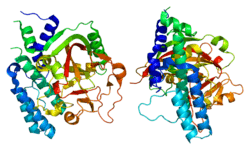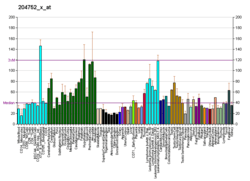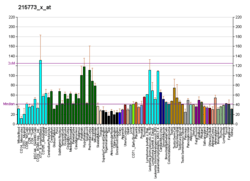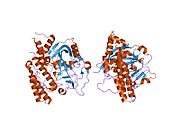PARP2
Poly [ADP-ribose] polymerase 2 is an enzyme that in humans is encoded by the PARP2 gene.[5][6][7] It is one of the PARP family of enzymes.
Function
This gene encodes poly(ADP-ribosyl)transferase-like 2 protein, which contains a catalytic domain and is capable of catalyzing a poly(ADP-ribosyl)ation reaction. This protein has a catalytic domain which is homologous to that of poly (ADP-ribosyl) transferase, but lacks an N-terminal DNA binding domain which activates the C-terminal catalytic domain of poly (ADP-ribosyl) transferase. The basic residues within the N-terminal region of this protein may bear potential DNA-binding properties, and may be involved in the nuclear and/or nucleolar targeting of the protein. Two alternatively spliced transcript variants encoding distinct isoforms have been found.[7]
PARP inhibitor drugs
Some PARP inhibitor anti-cancer drugs (primarily aimed at PARP1) also inhibit PARP2, e.g. niraparib.
Interactions
References
- 1 2 3 GRCh38: Ensembl release 89: ENSG00000129484 - Ensembl, May 2017
- 1 2 3 GRCm38: Ensembl release 89: ENSMUSG00000036023 - Ensembl, May 2017
- ↑ "Human PubMed Reference:".
- ↑ "Mouse PubMed Reference:".
- ↑ Johansson M (Aug 1999). "A human poly(ADP-ribose) polymerase gene family (ADPRTL): cDNA cloning of two novel poly(ADP-ribose) polymerase homologues". Genomics. 57 (3): 442–5. doi:10.1006/geno.1999.5799. PMID 10329013.
- ↑ Yélamos J, Schreiber V, Dantzer F (Apr 2008). "Toward specific functions of poly(ADP-ribose) polymerase-2". Trends Mol Med. 14 (4): 169–78. doi:10.1016/j.molmed.2008.02.003. PMID 18353725.
- 1 2 "Entrez Gene: PARP2 poly (ADP-ribose) polymerase family, member 2".
- ↑ Schreiber V, Amé JC, Dollé P, Schultz I, Rinaldi B, Fraulob V, Ménissier-de Murcia J, de Murcia G (Jun 2002). "Poly(ADP-ribose) polymerase-2 (PARP-2) is required for efficient base excision DNA repair in association with PARP-1 and XRCC1". J. Biol. Chem. United States. 277 (25): 23028–36. doi:10.1074/jbc.M202390200. ISSN 0021-9258. PMID 11948190.
Further reading
- Bashford CL, Chance B, Lloyd D, Poole RK (1981). "Oscillations of redox states in synchronously dividing cultures of Acanthamoeba castellanii and Schizosaccharomyces pombe". Biophys. J. 29 (1): 1–11. Bibcode:1980BpJ....29....1B. doi:10.1016/S0006-3495(80)85114-9. PMC 1328658. PMID 7260241.
- Berghammer H, Ebner M, Marksteiner R, Auer B (1999). "pADPRT-2: a novel mammalian polymerizing(ADP-ribosyl)transferase gene related to truncated pADPRT homologues in plants and Caenorhabditis elegans". FEBS Lett. 449 (2–3): 259–63. doi:10.1016/S0014-5793(99)00448-2. PMID 10338144.
- Amé JC, Rolli V, Schreiber V, Niedergang C, Apiou F, Decker P, Muller S, Höger T, Ménissier-de Murcia J, de Murcia G (1999). "PARP-2, A novel mammalian DNA damage-dependent poly(ADP-ribose) polymerase". J. Biol. Chem. 274 (25): 17860–8. doi:10.1074/jbc.274.25.17860. PMID 10364231.
- Still IH, Vince P, Cowell JK (2000). "Identification of a novel gene (ADPRTL1) encoding a potential Poly(ADP-ribosyl)transferase protein". Genomics. 62 (3): 533–6. doi:10.1006/geno.1999.6024. PMID 10644454.
- Schreiber V, Amé JC, Dollé P, Schultz I, Rinaldi B, Fraulob V, Ménissier-de Murcia J, de Murcia G (2002). "Poly(ADP-ribose) polymerase-2 (PARP-2) is required for efficient base excision DNA repair in association with PARP-1 and XRCC1". J. Biol. Chem. 277 (25): 23028–36. doi:10.1074/jbc.M202390200. PMID 11948190.
- Saxena A, Wong LH, Kalitsis P, Earle E, Shaffer LG, Choo KH (2003). "Poly(ADP-ribose) polymerase 2 localizes to mammalian active centromeres and interacts with PARP-1, Cenpa, Cenpb and Bub3, but not Cenpc". Hum. Mol. Genet. 11 (19): 2319–29. doi:10.1093/hmg/11.19.2319. PMID 12217960.
- Malanga M, Althaus FR (2004). "Poly(ADP-ribose) reactivates stalled DNA topoisomerase I and Induces DNA strand break resealing". J. Biol. Chem. 279 (7): 5244–8. doi:10.1074/jbc.C300437200. PMID 14699148.
- Kimura K, Wakamatsu A, Suzuki Y, Ota T, Nishikawa T, Yamashita R, Yamamoto J, Sekine M, Tsuritani K, Wakaguri H, Ishii S, Sugiyama T, Saito K, Isono Y, Irie R, Kushida N, Yoneyama T, Otsuka R, Kanda K, Yokoi T, Kondo H, Wagatsuma M, Murakawa K, Ishida S, Ishibashi T, Takahashi-Fujii A, Tanase T, Nagai K, Kikuchi H, Nakai K, Isogai T, Sugano S (2006). "Diversification of transcriptional modulation: Large-scale identification and characterization of putative alternative promoters of human genes". Genome Res. 16 (1): 55–65. doi:10.1101/gr.4039406. PMC 1356129. PMID 16344560.
- Maeda Y, Hunter TC, Loudy DE, Davé V, Schreiber V, Whitsett JA (2006). "PARP-2 interacts with TTF-1 and regulates expression of surfactant protein-B". J. Biol. Chem. 281 (14): 9600–6. doi:10.1074/jbc.M510435200. PMID 16461352.
- Chevanne M, Calia C, Zampieri M, Cecchinelli B, Caldini R, Monti D, Bucci L, Franceschi C, Caiafa P (2007). "Oxidative DNA damage repair and parp 1 and parp 2 expression in Epstein-Barr virus-immortalized B lymphocyte cells from young subjects, old subjects, and centenarians". Rejuvenation Res. 10 (2): 191–204. doi:10.1089/rej.2006.0514. PMID 17518695.
- Liang YC, Hsu CY, Yao YL, Yang WM (2011). "PARP-2 regulates cell cycle-related genes through histone deacetylation and methylation independently of poly(ADP-ribosyl)ation". Biochem Biophys Res Commun. 431 (1): 58–64. doi:10.1016/j.bbrc.2012.12.092. PMID 23291187.
External links
- PARP2 human gene location in the UCSC Genome Browser.
- PARP2 human gene details in the UCSC Genome Browser.








